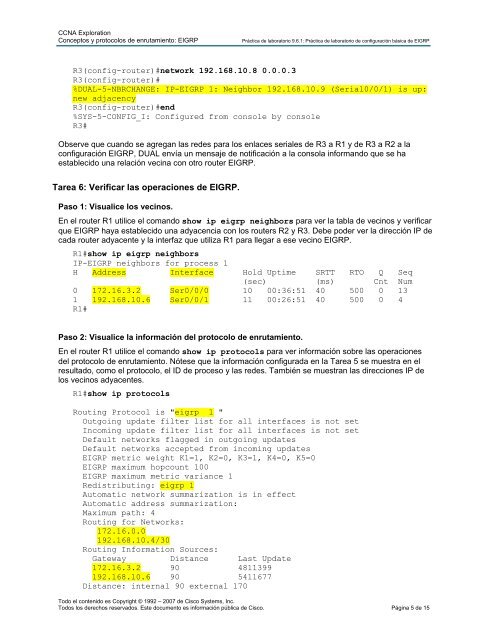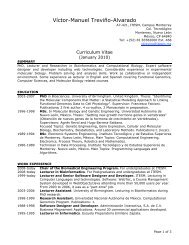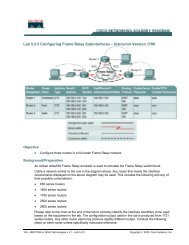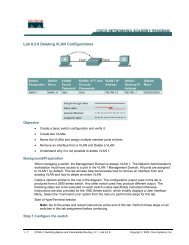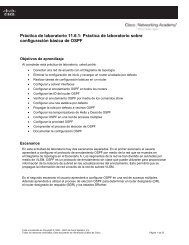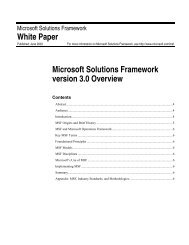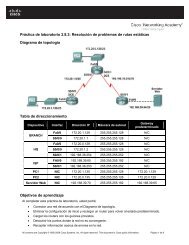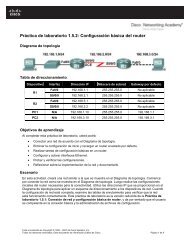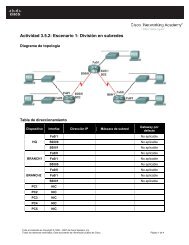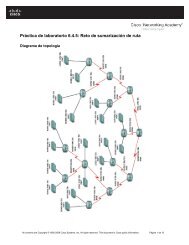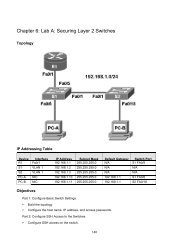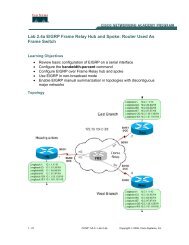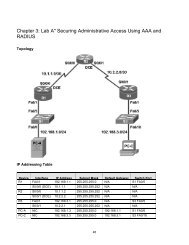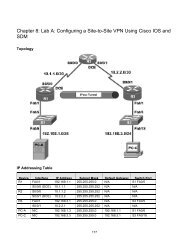Práctica de laboratorio 9.6.1: Práctica de laboratorio de ...
Práctica de laboratorio 9.6.1: Práctica de laboratorio de ...
Práctica de laboratorio 9.6.1: Práctica de laboratorio de ...
- No tags were found...
You also want an ePaper? Increase the reach of your titles
YUMPU automatically turns print PDFs into web optimized ePapers that Google loves.
CCNA Exploration<br />
Conceptos y protocolos <strong>de</strong> enrutamiento: EIGRP<br />
Práctica <strong>de</strong> <strong>laboratorio</strong> <strong>9.6.1</strong>: Práctica <strong>de</strong> <strong>laboratorio</strong> <strong>de</strong> configuración básica <strong>de</strong> EIGRP<br />
R3(config-router)#network 192.168.10.8 0.0.0.3<br />
R3(config-router)#<br />
%DUAL-5-NBRCHANGE: IP-EIGRP 1: Neighbor 192.168.10.9 (Serial0/0/1) is up:<br />
new adjacency<br />
R3(config-router)#end<br />
%SYS-5-CONFIG_I: Configured from console by console<br />
R3#<br />
Observe que cuando se agregan las re<strong>de</strong>s para los enlaces seriales <strong>de</strong> R3 a R1 y <strong>de</strong> R3 a R2 a la<br />
configuración EIGRP, DUAL envía un mensaje <strong>de</strong> notificación a la consola informando que se ha<br />
establecido una relación vecina con otro router EIGRP.<br />
Tarea 6: Verificar las operaciones <strong>de</strong> EIGRP.<br />
Paso 1: Visualice los vecinos.<br />
En el router R1 utilice el comando show ip eigrp neighbors para ver la tabla <strong>de</strong> vecinos y verificar<br />
que EIGRP haya establecido una adyacencia con los routers R2 y R3. Debe po<strong>de</strong>r ver la dirección IP <strong>de</strong><br />
cada router adyacente y la interfaz que utiliza R1 para llegar a ese vecino EIGRP.<br />
R1#show ip eigrp neighbors<br />
IP-EIGRP neighbors for process 1<br />
H Address Interface Hold Uptime SRTT RTO Q Seq<br />
(sec) (ms) Cnt Num<br />
0 172.16.3.2 Ser0/0/0 10 00:36:51 40 500 0 13<br />
1 192.168.10.6 Ser0/0/1 11 00:26:51 40 500 0 4<br />
R1#<br />
Paso 2: Visualice la información <strong>de</strong>l protocolo <strong>de</strong> enrutamiento.<br />
En el router R1 utilice el comando show ip protocols para ver información sobre las operaciones<br />
<strong>de</strong>l protocolo <strong>de</strong> enrutamiento. Nótese que la información configurada en la Tarea 5 se muestra en el<br />
resultado, como el protocolo, el ID <strong>de</strong> proceso y las re<strong>de</strong>s. También se muestran las direcciones IP <strong>de</strong><br />
los vecinos adyacentes.<br />
R1#show ip protocols<br />
Routing Protocol is "eigrp 1 "<br />
Outgoing update filter list for all interfaces is not set<br />
Incoming update filter list for all interfaces is not set<br />
Default networks flagged in outgoing updates<br />
Default networks accepted from incoming updates<br />
EIGRP metric weight K1=1, K2=0, K3=1, K4=0, K5=0<br />
EIGRP maximum hopcount 100<br />
EIGRP maximum metric variance 1<br />
Redistributing: eigrp 1<br />
Automatic network summarization is in effect<br />
Automatic address summarization:<br />
Maximum path: 4<br />
Routing for Networks:<br />
172.16.0.0<br />
192.168.10.4/30<br />
Routing Information Sources:<br />
Gateway Distance Last Update<br />
172.16.3.2 90 4811399<br />
192.168.10.6 90 5411677<br />
Distance: internal 90 external 170<br />
Todo el contenido es Copyright © 1992 – 2007 <strong>de</strong> Cisco Systems, Inc.<br />
Todos los <strong>de</strong>rechos reservados. Este documento es información pública <strong>de</strong> Cisco. Página 5 <strong>de</strong> 15


